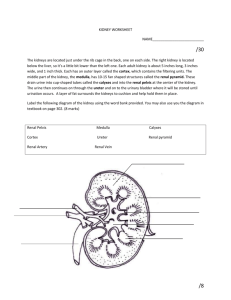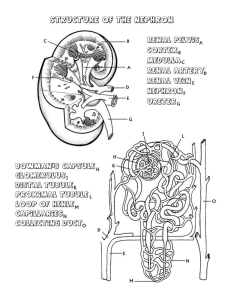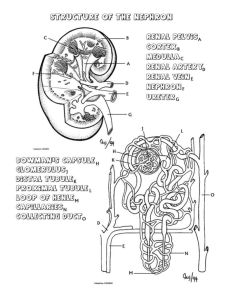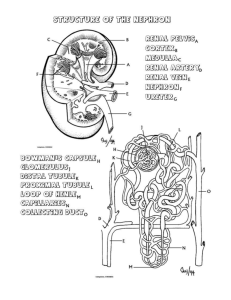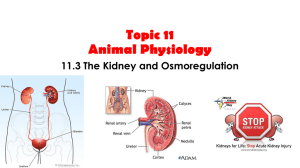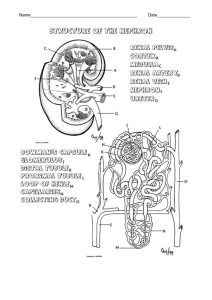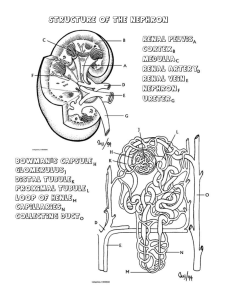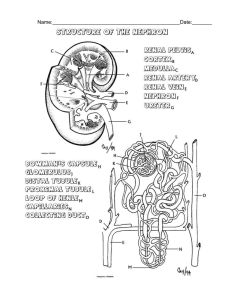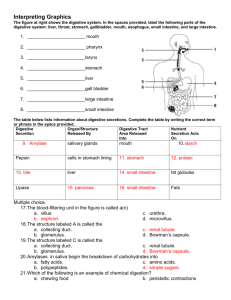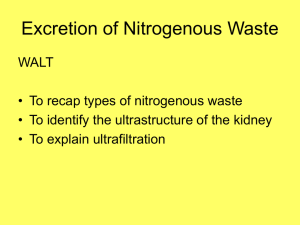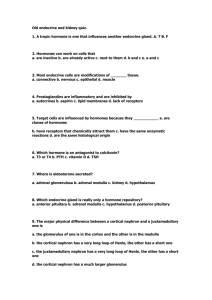Kidney Worksheet Key: Anatomy & Nephron Function
advertisement
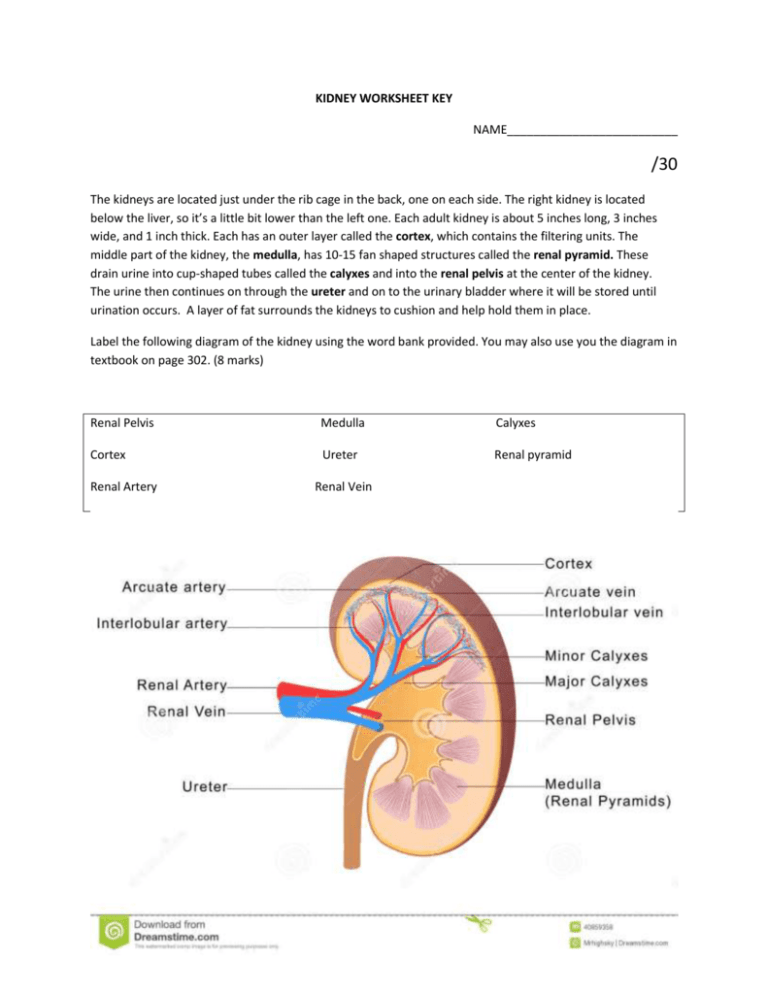
KIDNEY WORKSHEET KEY NAME__________________________ /30 The kidneys are located just under the rib cage in the back, one on each side. The right kidney is located below the liver, so it’s a little bit lower than the left one. Each adult kidney is about 5 inches long, 3 inches wide, and 1 inch thick. Each has an outer layer called the cortex, which contains the filtering units. The middle part of the kidney, the medulla, has 10-15 fan shaped structures called the renal pyramid. These drain urine into cup-shaped tubes called the calyxes and into the renal pelvis at the center of the kidney. The urine then continues on through the ureter and on to the urinary bladder where it will be stored until urination occurs. A layer of fat surrounds the kidneys to cushion and help hold them in place. Label the following diagram of the kidney using the word bank provided. You may also use you the diagram in textbook on page 302. (8 marks) Renal Pelvis Medulla Calyxes Cortex Ureter Renal pyramid Renal Artery Renal Vein If you view a nephron close up, as shown below, you can see that it is a complex structure composed of my tubes, and each kidney has about 1 million nephrons. The nephron’s primary function it to filter water from the blood. The nephron has 3 major parts: the Glomerulus, the Bowman’s Capsule, and the tubules, which consist of the proximal and distal tubule and the loop of Henle. _C__ Efferent Arteriole _D__ Proximal Convoluted Tubule _K__ Renal Artery _H__ Capillary network _A__ Bowman’s Capsule _E__ Loop of Henle _G__ Ascending limb _F__ Descending limb _I__ Distal Convoluted Tubule _B__ Afferent Arteriole _J__ Renal Vein _L__ Collecting duct /12 Blood enters the kidney from the renal artery and moves into the glomerulus, where filtration occurs. Filtration is the process by which water and dissolved particles are pulled out of the blood. The resulting liquid, called filtrate contains many of the toxic substances that might have accumulated in the blood (like ammonia). The glomerulus is enclosed by Bowman’s capsule, where small molecules and water can pass through this area but larger molecules do not. The filtrate is then collected in the Bowman’s capsule and ready for transport through the nephron. The nephron itself will restore vital nutrients and water back into the blood, while retaining waste produces the body needs to eliminate. The processes to accomplish this task are tubular reabsorption and tubular secretion. During tubular reabsorption, cells in the proximal tubule remove water and nutrients from the filtrate and pass them back into the blood. Wastes such as urea are retained in the tubule. During secretion, wastes that were not initially filtered out in the Bowman’s capsule are removed from the blood in the distal tubule. Ammonia and many drugs are removed from the blood during tubular reabsorption. Notice capillaries that wrap around the tubule. At the point of contact with the tubule and the capillaries, water and nutrients are reabsorbed into the blood. Wastes remain in the blood after filtration are also passed to the tubule. The filtrate flow from the proximal tubule and into the Loop of Henle. The loop of Henle concentrates the filtrate by removing more water from it, and passes it to the distal tubule and then goes into the collecting duct. It is now called urine. The collecting duct prepares the urine for transport out the body. It is collected in the renal pelvis where is eventually enter the ureter. From there it goes to the bladder. Label the parts of the nephron using the word bank provided. You may also use you the diagram in textbook on page 302. (12 marks) Questions Using the class notes and handouts please answer the following questions. 1. Where is the glomerulus located and what is its function? (2 marks) Located in Bowman’s Capsule Function is to filter waster/small molecules out of blood into the filtrate 2. What types of cells is the glomerulus made up of and why are these important in the filtration of blood? (2 marks) Podocyte cells They only allow small molecules to be filtered through 3. What is the filtrate? (2 marks) Small moolcues that have been filtered through the glomerulus It is blood that has been filtere through the glomerulus that enters the nephron’s tubules 4. What is tubular reabsorption and why is it important? (2 marks) Is when the filtrate is reabsorbed back into the blood stream. This is important because it allows the body to reabsorb nutrients and water that it needs to function. 5. Where does secretion occur (1 mark) Distal convoluted Tubule 6. After secretion the urine enters the collecting duct and enters what part of the kidney? (1 mark) Renal Pelvis /10
